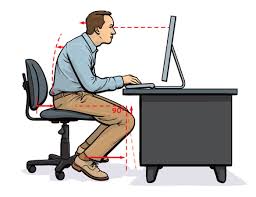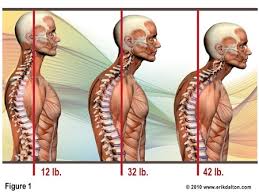Twelve hours a day at the computer. Neck and shoulders. You know what I’m talking about. Winds up tighter and tighter, like a clock, the longer you sit there staring at that monitor. Looking down at your fingers while you type, leaning forward, holding the phone on one side while you type, faxing, scanning, incessant little fine movements with the mouse hand. Sometimes in the afternoon it gets so bad you claw involuntarily at the base of the neck trying to get some relief from the tension and the electric shock sensations that are shooting out across the upper shoulders, those rocklike traps.
Getting the finger numbness yet? Be patient – it’s coming.
Then there’s the shoulder restriction thing, where it gets difficult to raise your arms high enough to put on a sweater, and you’re not even old, you know? And also the “tension” headaches which one doctor has told you were “cluster” or migraine…ever notice how they’re brought on or aggravated by episodes of extreme neck pain and tension? Or you might be getting those shooting things into your skull, especially across the occiputal area. You know the kind – where the Motrin 800s might as well be M&Ms.
Remember when you used to be able to back your car up without turning your entire body around, just the neck? Or maybe you’re a neck cracker, where you lean your head way over real far until it cracks and you get some “relief.” Only it’s really not relief, because 10 minutes later you have to do it again.
Or maybe you go to the gym and work out and some personal trainer told you that you should just “work through it,” no pain no gain, etc. And you work your muscles into a tighter and tighter knot but at least you’re doing something about it. The Illusion of Motion mindset.
What do your colleagues say? Welcome to Silicon Valley. Goes with the territory. Used to be four people in your department – now it’s just you. Same workload. Friday on my mind.
STRESS?
That’s what you all say. “It’s just stress.” Horsefeathers. After years of hearing people pronounce this offhand dismissal of some very severe physical problems, I finally figured out what you mean. You’re saying, these slings and arrows directed at you from the world are totally beyond your control, beyond your responsibility or ability to prevent it in any way, so therefore why even try? Just accept them. Take Excedrin, and just keep your routine, day after day..
OK, get this straight, once and for all: if you live here, it’s impossible to eliminate stress from your life. Too many factors you can’t control: CalTrans, Santa Clara County this and that, the lower primates in the legislature, commuter lanes, The 101, Mercury News fairy tales, CNN, your family, their family, this week’s new PC, your kids getting dumber in their Common Core schools . .…
What you can control, however, is the way stress affects you physically. How? Physical stress, what stress does to the human body, is a cumulative load of many diverse factors whose only common thread seems to be that they are all focused at the base of you neck. Things cross the line – the emotional becomes physical – no headache until the call came in that Mother-in-law is flying up for the weekend, with the schnauzer. Or your biggest competitor just got the contract. Then all of a sudden – wham! Those steel-cable cords of muscle in the back of the head and neck are real – it’s not “just stress.”
There are two categories of stress factors that we CAN control:
-
biochemical
biomechanical
Normalizing these two areas as much as possible, in anticipation of the arrival of daily stresses we cannot control will serve to lessen their physical impact on the body – neck tension, shoulder tension, headache, numbness, etc.
For information on eliminating biochemical stress factors, please refer to the chapters on Enzymes, Allergies, and on the Colon (www.thedoctorwithin.com). Chemical toxicity from food and drugs tends to accumulate in muscles, joints, and ligaments. In the neck and shoulders, tension is jacked up, notch by notch with all those Cokes, coffee, chocolate, cigarettes, and indigestible “lunches” that are part of the Silicon Valley workday. The money might be focused here, but health is certainly not part of the package. Just look at the people in the restaurants and nightclubs – look what they’re eating and drinking. Beneath the designer labels, how do they really look? Healthy? Youthful? Fit? Look again.
The other area we can control is the biomechanical component. Distorted positions of the spine and muscles become locked into place for so many years that the body forgets what normal is. What do you think suffers by your 7 neck vertebrae, after eight or ten years, holding the phone on the right shoulder, no hands? Or whatever weird ergonomics your particular job requires.
The answer is nerves. Spinal nerves. Those branches of the spinal cord that run out between each two consecutive vertebrae become threatened by the odd configuration your muscles have been positioned in for the past few years. Nerve tissue is the most delicate of the entire body and the brain will do anything to protect it. So when the brain senses that the spinal nerves in your lower neck are in danger of being pinched because of the way you have been staring into that monitor for 22 hours a day, it sends a signal to the surrounding muscles to splint up in order to protect the nerves.
The muscles try to pull the vertebrae back into place, but they can’t. The vertebrae are locked like that. But the muscles keep trying anyway, and the tighter they get, the more out of place the vertebrae become. So it’s a vicious circle: muscles, bones, and nerves – and a downward spiral of well-being.
What a waste of energy. Think how much energy your body wastes keeping those muscles splinted up like that all the time. We’re talking 24 hours a day. It’s involuntary. You can’t just say to yourself, I think I’ll relax my traps today. Doesn’t work like that. Try this: tighten up your right biceps all the way. OK, now keep it like that for the next 24 hours. See what I mean? Feel all the energy that would be wasting? That’s exactly what’s going on in the muscles of the neck and upper back. That’s why you wake up exhausted in the morning.
This is also why cracking your own neck doesn’t work. It’s really just a nervous habit, brought on by the instinct that something is out of place, which is true. The problem is, the bones which are actually locked cannot be unlocked by auto-manipulation. They remain locked. The cracking noise comes from the ones above the locked segments, which now are becoming hypermobile (too sloppy) because of all this neck-cracking every 15 minutes. So no matter what you hear or what you see on TV at halftime, those neck crackers aren’t dong anything positive to help their problem. If they were, the problem would go away. Ask yourself, ever see a neck cracker break the habit because he finally “got it”? Doesn’t happen.
Discs are another big piece of the puzzle here. Discs are the cushions or spacers between the vertebrae. They are spongy, fluid-filled sacks of gel whose job is to act as shock absorbers for the vertebrae and keep them apart. The closer the vertebrae get together, the more the spinal nerves are threatened. So the body will do anything to preserve the disc space.
Discs are the only structure in the body without their own blood supply. The only way they can get nutrients and become hydrated is by absorbing the surrounding fluids. In the case of the locked lower neck vertebrae that have been immobile for the last twelve years because we’re –
-
…going through an audit
…going through a merger
…have a really big contract coming up
…having a Monday
The disc becomes trapped between the two immobile vertebrae, one atop the other. The vertebrae don’t move as they should, and the disc cannot become hydrated. Result: the disc dries out and gets worn out.
The more the discs wear out, the closer together the vertebrae get. In addition to muscle splinting, the body has another protective mechanism to keep the vertebrae from touching the spinal nerves. It’s this: the vertebrae begin to change their shape. Calcium deposits in the form of bone spurs begin to attach themselves to the vertebra, hanging off it like wax dripping from a candle. The sharp bony points may begin to irritate the surrounding tissues, causing inflammation. And that is a fairly accurate description of the onset of spinal arthritis.
Spinal arthritis is not normal, no matter how old the person is, no matter what the doctors say. Just because over 75% of the population over 65 has some form of arthritis doesn’t mean it’s normal. No arthritis is normal. The large majority of spinal arthritis is caused by locked vertebrae which gradually wear out the joint.
You may have heard that the normal human neck should have a curve, when viewed from the side. Actually it should be part of an arc of a circle 17cm in diameter. For various reasons, many of us have lost the normal curve and the neck may now be totally straight. This condition is called military neck, and can only be seen on X-ray. Some workers have a worse problem: the neck is actually curved in the opposite direction, having gone beyond the military neck stage. This is called reverse curve. Both these conditions are not normal and will probably cause eventual pain, pinched nerves, or disc problems.
Loss of neck curve has only two causes:
-
trauma
microtrauma
Trauma is when somebody drops a safe on your head from the third floor, or maybe you’re in a whiplash accident. Or the obstetrician is in too big a hurry when you’re born, and yanks or twists the neck too hard. All this is trauma. A blow to the head or neck can push the vertebrae out of their normal curve and lock them out of place. They can stay that way for years, or permanently if no one ever notices.
Microtrauma means a continual chain of little traumas day in, day out that ultimately can have the same effects as big trauma has. Microtrauma includes typing, looking down at the monitor, looking into a microscope, or any forced position you keep your body in to perform your daily job tasks. Silicon Valley people never stretch, never extend, and rarely exercise. The effects of microtrauma are sneaky and cumulative. It starts with intermittent annoying little pains and spasms which are fairly deniable for a long time. For many people, by the time they admit that they have a problem, that means it’s having a major impact on their lives, a situation of constant pain. They ignored all the warning signals for all those months and years because “the pain always went away.” Or “it’s just stress.”
Here’s the main surprise: the pain was never the problem. The pain was just the signal. The problem was that the spine was wearing out little by little as it tried to adapt to the weird configuration of bones and muscles after all those years of Silicon Valley. The problem was that the vertebrae are locked out of place. Those steel knots in the traps are entrenched, developed, and trained, just as faithfully as the muscles a bodybuilder focuses upon. The difference is, the knots are abnormal, actually pathological, since they have deleterious effects to overall health.
SOLUTIONS
For Silicon Valley syndrome, you don’t need surgery. And if drugs worked, you’d already be better, wouldn’t you? How long can you take pain drugs for Silicon Valley Syndrome before they’ll tell you to stop? Forever? A conservative estimate.
How long can the vertebrae remain locked out of place? Forever. Unless someone notices the distortion and corrects it. What are the main side effects of pain drugs (NSAIDs)? According to the Physician’s Desk Reference 2000, the answer is – digestive disorders. How? The drugs kill the friendly bacteria in the colon. Those bacteria had a purpose: the final stages of digestion. When you kill them, food just sits there and rots. For the whole story, please see the chapter on the Colon. It isn’t pretty.
Any solutions with no side effects? Well, there’s massage. Does it work? You bet. Until tomorrow, at least. As long as those muscles can be kneaded into relaxation, you’re fine. Until you sit down at your desk the next day and the screws start tightening. Massage is only slightly better than aspirin as a cure for Silicon Valley Syndrome.
WORKING OUT
Work through it. Doesn’t help. Even though exercise is generally good, in this case you’re locking in a false position of vertebrae ever tighter by strengthening the surrounding muscle configuration. Result is that it becomes much harder to make a correction because all those layers of protective muscle have to be dealt with. Such people may look fit, but they’re not. No one who has chronic pain is fit. Being in shape and being fit are two different things. People may be normal weight, with good muscle development and be totally unfit. Fitness must include normal relaxed muscle tone, not spasm, in the non-working muscles.
In the prone (lying face down) position, the back muscles should be totally relaxed. Try it. All that severe muscle rigidity in the upper and lower back while prone is totally unnecessary, protective, involuntary, a waste of energy, and a sign that something is wrong. This is called muscle overlay, because the problem is buried underneath.
SUBLUXATION
The underlying cause of Silicon Valley Syndrome. Locked vertebrae. To remove the cause, we must remove the subluxation. There is only one way to do that: adjust the spine. Accept no substitutes.
It is possible to resolve Silicon Valley Syndrome and be normal again. Depends on:
-
* How long it’s been there
* Any degeneration yet
* Degree of muscle overlay
* Amount of ongoing daily aggravation
* Level of commitment to change
* Finding the actual subluxation
* Finding the right chiropractor
Call 408 753 9830 – we’ll help you.
As long as you’re still alive, the condition is not hopeless. But one thing is certain: Silicon Valley Syndrome never resolves on its own. Degenerative spinal arthritis is a long-term, slowly progressing sequence of events, most of which involves simply doing nothing for several years. Waiting till you retire because you don’t have time to take care of it now is practically a guarantee of chronic pain, as well as having the spinal mobility of a telephone pole in your retirement years. How you gonna windsurf like that? Or sweep the veranda in the beachhouse? Or hop off the golfcart to make a shot? Answer: with great difficulty.
But what about now? If retirement is far, far in the future, what about now? This is your life. Is this good enough?
Silicon Valley Syndrome is empirically at around 80 or 90% incidence around here. The fatigue it causes prevents even people in their thirties from doing a lot of stuff in their free time. If all you want to do in your leisure time is veg, where’s the quality of life in that?
Correction of Silicon Valley Syndrome may involve a minor lifestyle change: adjustments and exercises take a bit of time and effort, no question about it. Most of us only make changes when the Universe sneezes at them – death, accidents, disaster, etc.
But some people see the warning signs that are pointed out to them, and take action. Find the doctor who can X-ray and locate the subluxation, and get it fixed. That’s all. Takes a little initiative, but if you score, you get your youth back. At the least, your free time.
If Silicon Valley people took half as good care of their spine as they do their car, there would be no Silicon Valley Syndrome. The first little knock or shimmy or warning light and that puppy is at the garage.
How many cars will you have in your lifetime? How many spines?
-
– Dr Tim O’Shea








